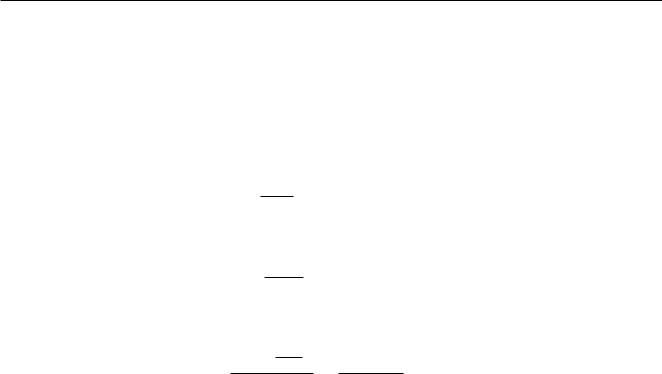

M1-TSE. Macro I. 2010-2011. Chapter 1: Solow Growth Model
Output per e ective unit of labor is
Y (t)
y (t) = A (t) L (t) = f (k (t))
where
f (k (t)) = F |
K (t) |
; 1 |
|
A (t) L (t) |
|||
|
|
is the \intensive form" of the production function. Dividing the capital accumulation equation by
A(t)L(t) we then have |
|
|
|
||
|
dK (t) |
1 |
|
= sy (t) k (t) : |
|
|
|
|
|
|
|
|
dt A (t) L (t) |
||||
4.2.1Evolution of capital per e ective unit of labor
To solve the model, it is su cient to describe the evolution of capital per e ective unit of labor k(t). To do so, we must rst take the time derivative of k(t) = K(t)=(A(t)L(t)). Note that it is
made up of several terms, we use standard calculus techniques to obtain |
|
|
||||||||||||||||||||||||||||
|
|
dt |
= A (t) L (t) dt |
|
|
(A (t) L (t))2 |
L (t) dt |
+ A (t) |
dt |
|||||||||||||||||||||
|
|
dk (t) |
|
|
1 |
|
|
dK (t) |
|
|
|
|
|
|
|
K (t) |
|
dA (t) |
|
dL (t) |
|
|||||||||
Using the facts that |
dA(t) |
|
= gA (t) and |
dL(t) |
|
= nL (t), we have |
|
|
|
|||||||||||||||||||||
dt |
|
dt |
|
|
|
|||||||||||||||||||||||||
|
|
|
|
|
|
|
|
|
|
|
|
|
|
|
|
|
|
|
|
|
|
|
||||||||
|
dk (t) |
|
= |
|
1 |
|
|
|
dK (t) |
|
|
|
K (t) |
|
[L (t) gA (t) + A (t) nL (t)] |
|||||||||||||||
|
|
|
|
|
|
|
|
|
|
|
|
|
|
|
|
|
|
|
|
|||||||||||
|
|
dt |
|
|
A (t) L (t) dt |
|
|
|
(A (t) L (t))2 |
|||||||||||||||||||||
|
|
|
|
|
= |
|
1 |
|
|
|
dK (t) |
|
K (t) |
[g + n] |
|
|
|
|||||||||||||
|
|
|
|
|
|
|
|
|
|
|
|
|
|
|
|
|
|
|
|
|
|
|||||||||
|
|
|
|
|
|
A (t) L (t) dt |
|
|
|
A (t) L (t) |
|
|
|
|||||||||||||||||
|
|
|
|
|
= |
|
1 |
|
|
|
dK (t) |
k (t) [g + n] |
|
|
|
|||||||||||||||
|
|
|
|
|
|
|
|
|
|
|
|
|
|
|
|
|
|
|||||||||||||
|
|
|
|
|
|
A (t) L (t) dt |
|
|
|
|
|
|
||||||||||||||||||
From the capital accumulation equation we have: |
|
|
|
|
|
|||||||||||||||||||||||||
|
|
|
|
|
|
|
|
|
|
|
|
1 |
|
|
|
dK (t) |
|
|
|
|
|
|||||||||
|
|
|
|
|
|
|
|
|
|
|
|
|
|
|
|
|
= sy (t) k (t) |
|
|
|
||||||||||
|
|
|
|
|
|
|
|
|
|
A (t) L (t) dt |
|
|
|
|
||||||||||||||||
Plugging this equation in our expression for |
dk(t) |
, we obtain the equation describing the evolution |
||||||||||||||||||||||||||||
|
dt |
|||||||||||||||||||||||||||||
|
|
|
|
|
|
|
|
|
|
|
|
|
|
|
|
|
|
|
|
|
|
|
|
|
|
|
|
|
|
|
of capital per e ective unit of labor: |
|
|
|
|
|
|
|
|
|
|
|
|
|
|
|
|
||||||||||||||
|
|
|
|
|
|
|
|
dk (t) |
|
|
|
|
|
|
|
|
|
|
|
|
|
|
|
|
||||||
|
|
|
|
|
|
|
|
|
|
|
|
|
= sf (k (t)) (g + n + ) k (t) : |
|
|
|
||||||||||||||
|
|
|
|
|
|
|
|
|
|
dt |
|
|
|
|
|
|||||||||||||||
|
|
|
|
|
|
|
|
|
|
|
|
|
|
|
|
|
|
|
|
|
11 |
|
|
|
|
|
|
|||

M1-TSE. Macro I. 2010-2011. Chapter 1: Solow Growth Model
4.3Model dynamics
The evolution for k(t) satis es:
dk (t) = sf (k (t)) (g + n + ) k (t) : dt
The rst term in this expression is actual savings (or investment) per e ective unit of labor. The second term in this expression is the "required investment" to maintain a constant capital per e ective unit of labor k(t). In other words, to maintain a constant k(t), investment per e ective unit of labor must cover growth in the economy owing to both technology and population growth (g + n)k (t) and depreciation of existing capital k (t).
When actual investment sf(k(t)) exceeds required investment, k (t), is growing. When actual investment is below required investment, k(t) is decreasing.
At the point,
sf (k (t)) = (g + n + ) k (t)
the economy is in steady-state with a constant k(t) = k . Because f(k(t)) is concave, it is easy to show that
dk (t) > 0 for k (t) < k dt
and
dk (t) < 0 for k (t) > k dt
In words, if capital is below the steady-state value, k (t) is increasing. If capital is above the steadystate value, k(t) is decreasing. These results are also apparent from the Figure 4.3 next page, since, when k(t) < k is low, sf(k (t)) > (g + n + )k (t) and investment exceeds the break-even amount (the green line is above the blue line) and vice versa. This implies stable dynamics{regardless of where we start, we will eventually converge to the steady-state value k .
The Figure 4.3 depicts the relationship between the change in k(t) and the level of k(t). For k (t) < k we have dk(t)=dt > 0 and for k (t) > k we have dk(t)=dt < 0.
12

M1-TSE. Macro I. 2010-2011. Chapter 1: Solow Growth Model
Figure 1: Steady state capital level k
Figure 2: Dynamics of k (t)
13

M1-TSE. Macro I. 2010-2011. Chapter 1: Solow Growth Model
4.4Steady state
The steady-state of this economy occurs at the point k where
sf (k ) = (g + n + ) k
Because f(k) is concave, it is easy to verify that an increase in s must cause an increase in k . These results may be seen by plotting the investment line, sf(k) and the required investment line (g+n+ )k on the same graph and examining the e ect of a change in s on the point of intersection of these two lines. Similarly, an increase in the term (g + n + ) causes a reduction in k . This is Figure 4.4.
Figure 3: Comparative statics for k
To obtain an algebraic solution for the steady-state value of k(t) we must specify a production function. With Cobb-Douglas production,
Y (t) = K (t) (A (t) L (t))1
and in intensive form we have
f (k) = k
where 2 [0; 1]. The steady state k satis es
s (k ) = (g + n + ) k :
14

M1-TSE. Macro I. 2010-2011. Chapter 1: Solow Growth Model
Solving for k we have
1
k = |
s |
|
1 |
|
|
: |
|||
g + n + |
||||
From this expression, we can readily see that an increase in the savings rate s will raise k* while an increase in g + n + will lower k .
With the Cobb-Douglas case, we can also calculate the e ect of an increase in savings on output. Note that
y = (k )
so that
|
|
|
|
|
|
|
|
|
|
|
|
|
|
|
|
|
|||||
|
|
|
|
|
s |
|
|
|
|
|
|
|
|
||||||||
|
y = |
|
|
|
|
|
|
|
|
|
1 |
: |
|
||||||||
|
|
|
|
|
|
|
|
|
|
|
|
|
|
||||||||
|
|
g + n + |
|||||||||||||||||||
Taking logs we have |
|
|
|
|
|
|
|
|
|
|
|
|
|
|
|
|
|
|
|
|
|
log y = |
|
|
[log s log (g + n + )] : |
||||||||||||||||||
|
|
|
|
|
|||||||||||||||||
|
1 |
||||||||||||||||||||
Taking now derivatives, we have |
|
|
|
|
|
|
|
|
|
|
|
|
|
|
|
|
|
|
|
|
|
|
|
|
d log y |
= |
|
|
|
|
|
|
|||||||||||
|
|
|
d log s |
|
1 |
|
|
||||||||||||||
|
|
|
|
|
|
|
|
||||||||||||||
Note that, generally speaking, |
|
|
|
|
|
|
|
|
|
dy |
|
|
|
|
|
|
|
|
|
|
|
|
d log y |
|
|
|
|
|
|
|
|
%y |
|
||||||||||
|
= |
|
|
y |
|
|
= |
|
|||||||||||||
|
d log s |
|
ds |
|
|
%s |
|||||||||||||||
|
|
|
|
|
|
|
|
|
|||||||||||||
|
|
|
|
|
s |
|
|
|
|
||||||||||||
|
|
|
|
|
|
|
|
|
|
|
|
|
|
|
|
|
|
|
|
|
|
so that the elasticity of output with respect to savings is |
|
|
|||||||||||||||||||
|
|
|
|
%y |
|
= |
|
|
|
|
|
|
|||||||||
|
|
|
|
%s |
1 |
|
|
||||||||||||||
|
|
|
|
|
|
|
|
||||||||||||||
If = 13 (which makes sense empirically), this result above implies that a 10% increase in savings leads to a 5% increase in output per capita.
4.5Summary
The Solow growth model implies a transition equation for capital per unit of e ective labor of the
form
dk (t) = sf (k (t)) (g + n + ) k (t) : dt
which has a unique steady-state that satis es
sf (k ) = (g + n + ) k
15

M1-TSE. Macro I. 2010-2011. Chapter 1: Solow Growth Model
and stable dynamics around this steady state{at k below k , k is increasing, and at k above k , k is decreasing.
Increases in the savings rate lead to a permanent increase in the level of capital per e ective unit of labor, and hence output per e ective unit of labor. Measuring living standards as output per worker
Y (t) = A (t) f (k (t))
L (t)
the steady-state level of output per worker is
Y (t) = A (t) f (k )
L (t)
while the growth rate of output per worker in steady-state is
d log Y (t) = d log A (t) = g dt dt
A rise in the savings rate leads to a permanent increase in output per worker but does not in uence the long-run growth rate.
5Consumption
In the Solow growth model consumption is equal to output minus investment:
C (t) = Y (t) I (t) :
Since investment is proportional to output, we have
C (t) = (1 s) Y (t) :
Let c(t) = C(t)=(A(t)L(t)) denote consumption per e ective unit of labor. Dividing through by e ective units of labor we have
c (t) = (1 s) y (t) :
The e ect of an increase in savings has an ambiguous e ect on consumption. To see this, note that, holding y(t) xed, an increase in the savings rate would reduce consumption. The increase in the savings rate also increase output y(t) however. In the short-run, we expect that the e ect on output is small and an increase in the savings rate would reduce consumption at least temporarily.
16

|
dc |
|
|
|
|
|
|
|
|
|
|
|
|||||
|
|
ds |
|
|
|
|
|
|
|
|
|
|
|
|
|||
From our solution for y we can compute |
|
|
|
|
|
|
|
|
|
|
|
||||||
|
|
|
|
|
|
dy |
= |
|
|
|
y |
|
|||||
|
|
|
|
|
|
|
1 s |
||||||||||
|
|
|
|
|
|
ds |
|||||||||||
so that |
|
|
|
|
|
|
|
|
|
|
|
|
|
|
|
||
dc |
|
|
|
|
|
(1 |
s) |
||||||||||
|
|
= |
|
|
1 y |
||||||||||||
|
ds |
s (1 ) |
|||||||||||||||
|
|
|
= |
|
s |
y : |
|||||||||||
|
|
|
|
|
|
|
(1 ) s |
||||||||||
This implies that |
|
|
|
|
|
|
|
|
|
|
|
|
|
|
|
||
|
|
|
dc |
> |
0 if s < ; |
||||||||||||
|
|
|
|
ds |
|||||||||||||
|
|
|
dc |
< |
0 if s > : |
||||||||||||
|
|
|
|
ds |
|||||||||||||
These results show that, for low levels of the savings rate, an increase in savings will raise consumption and therefore raise the long-run level of household well-being. At high levels of the savings rates, an increase in the savings rate would reduce consumption and therefore reduce the long-run level of household well-being.
6Convergence
An important question for growth is whether or not poor countries will catch up to rich countries through more rapid growth. To study this question, consider the percentage change in kt:
d log k (t) |
= |
dk (t) 1 |
: |
||||
|
|
|
|
|
|
||
dt |
|
|
dt k (t) |
||||
|
|
|
|||||
|
|
17 |
|
|
|
||

M1-TSE. Macro I. 2010-2011. Chapter 1: Solow Growth Model
From the transition equation for k(t) we have
d log k (t) = sf (k (t)) (g + n + ) dt k (t)
Since f(k)=k is decreasing in k, the growth rate of k(t) is high when k(t) is low.
Unconditional convergence. For two countries with identical technologies, savings rates, production structures and population growth rates, the Solow model implies that the poorer country{ i.e. the country with a lower initial level of capital and hence output per capita will grow at a faster rate than the rich country. Over time, the living standard of the poor country will catch up to that of the rich country. The living standards of these two economies will converge to the same level. This is often called unconditional convergence in the growth literature.
Conditional convergence. Now consider two countries with di erent initial levels of technology but the same savings rates, production structures and population growth rates. Furthermore, suppose that each country's technology grows at the same rate, so that one country has a permanently higher level of technology than another country. In this case, although neither country may start out at the steady-state, both economies will eventually converge to steady states with the same level of capital per e ective unit of labor k and, in the long-run therefore will have the same levels of output per e ective unit of labor y . The gap between the rich (technologically advanced) economy and the poor (technologically behind) will remain, and will re ect the di erences in the initial levels of technology.
Conditional on this technology gap, these countries will in the long-run experience the same growth rate. Similarly, if one country saves more than another country on a permanent basis, these countries will also experience the same growth rate in the long-run but will exhibit permanent di erences in the level of income per capita. Such convergence in growth rates is often referred to as \conditional convergence".
18

M1-TSE. Macro I. 2010-2011. Chapter 1: Solow Growth Model
7Implications of the Solow Growth Model
7.1Living standards in the long run
The Solow Growth Model implies that the economy will achieve a balanced growth path where GDP per capita grows at a constant rate equal to the rate of technological change.
An increase in the savings rate will raise the level of GDP per capita.
An increase in the population growth rate will lower the level of GDP per capita.
Changes in population growth or savings rate will not a ect the long-run growth of GDP per capita.
7.2Convergence
If all countries have access to the same technology At and the same savings rate, the Solow model implies convergence in per-capital incomes Yt=Lt, i.e. everything else equal, the Solow model implies that a poor country should grow faster than a rich country and catch up.
If countries di er in terms of the initial level of technology or savings rates they will not converge to the same per capita income levels.
If the rate of technological growth is the same across countries, the Solow growth model implies that the growth rates of income per capita should converge even if the levels do not.
7.3Some empirical ndings
The data imply that countries have not been converging in per capita income terms.
Controlling for savings rates and other long-run determinants of income, one tends to nd that initial income is negatively correlated with growth rates, implying \conditional convergence".
Mankiw-Romer-Weil argue that an augmented version of the Solow model ts the data very well in terms of convergence properties across countries (i.e. poor countries do tend to grow faster than rich ones in a manner similar to that described by model dynamics). The
19

M1-TSE. Macro I. 2010-2011. Chapter 1: Solow Growth Model
augmented model allows for human as well as physical capital accumulation. The authors argue that the true capital share should incorporate human as well as physical capital, in which case Kt is better measured as 23 rather than 13 . With a higher capital share, the model converges more slowly and is better able to t the facts.
8Growth Accounting
The neoclassical production structure embedded in the Solow Growth Model provides a convenient accounting framework which one may use to decompose the various sources of growth. We begin by presenting the growth accounting formula. To use this formula we need to add some assumptions regarding markets and market structure.
8.1Growth Accounting formula
In this section we obtain the formula for growth accounting based on the Solow Model. For this we come back to discrete time because the data necessary for this procedure (mainly coming from National Accounting) has commonly quarterly frequency.
Let's start with the familiar Cobb-Douglas case:
Yt = Kt (AtLt)1
Taking logs we have
log Yt = log Kt + (1 ) log Lt + (1 ) log At
Similarly, if we took logs of the production function at time t 1 we would have:
log Yt 1 = log Kt 1 + (1 ) log Lt 1 + (1 ) log At 1
Taking the di erence between these two equations,
log Yt = log Kt + (1 ) log Lt + (1 ) log At |
(2) |
Note that for any variable X |
= log (Xt) log (Xt 1) = log |
Xt t |
|
|
|
log Xt |
1 |
||||
|
|
|
X |
|
|
20
